Expanded story from: “Striking Eight Bells: A Vietnam Memoir.”
“Operation Pocket Money and Operation Custom Tailor.”
“Another story on what most Americans don’t know about the Navy’s role in the Vietnam War?”
Most Americans probably believed that by 1972, the war in Vietnam was essentially winding down. However, for the U.S. Navy in Vietnam, 1972 would prove to be a busy year of conducting numerous and dangerous combat operations. On May 8, 1972, President Richard Nixon ordered the mining of Haiphong Harbor’s approaches and channels. Nixon defended his escalation of the air and sea war as crucial to cut off the flow of supplies to North Vietnamese troops fighting in the South and to protect the lives of American forces still in Vietnam. Also, Nixon contended that the raids and the mining were calculated to pressure the North Vietnamese government into resuming critical negotiations to achieve peace in Vietnam.1
President Nixon’s orders required the U.S. Navy’s 7th Fleet to put together two joint-operations. The task of one operation would be the aerial seeding of mines at the approaches and channel into Haiphong Harbor; the task of the second operation would be to suppress gunfire from the North Vietnamese shore batteries located principally on Cat Ba Island and along the Do Son Peninsula. The two operations were called “Operation Pocket Money” and “Operation Custom Tailor.”
“Operation Pocket Money.” An aerial mining campaign conducted by U.S. Navy Task Force 77 against North Vietnam on May 9, 1972 (Vietnam time). The purpose was to halt or slow the transportation of supplies and materials for the Nguyen Hue Offensive or Easter Offensive, an invasion of the Republic of Vietnam (South Vietnam), by forces of the People’s Army of Vietnam (PAVN), launched on March 30. Pocket Money was the first use of naval mines against North Vietnam. Three A-6 Intruders carried 1,000-pound (450 kg) Mark 52 magnetic mines to be dropped in Haiphong’s inner channel; all Mark 52-2 mines were set with 72-hour arming delays, in order to permit merchant ships time for departure or a change in destination consistent with the President’s public warning. Six Navy A-7 Corsair IIs carried 500-pound (230 kg) Mark 36 acoustic mines that were dropped in the outer portion of the channel. Each plane carried four mines.3
To support Task Force 77 (Operation Pocket Money), at daylight on May 9, Task Unit 77.1.2 a destroyer strike force struck the Haiphong Harbor air defense batteries with a 30-minute bombardment from their 5-inch (127mm) guns, which preceded the aerial mining. The strike force consisted of USS Richard S. Edwards (DD 950), USS Berkeley (DDG 15), USS Buchanan (DDG 14) and USS Myles C. Fox (DD 829). 3
Additionally, guided missile cruisers USS Long Beach (CGN 9) and USS Chicago (CG-11) had been moved north from the PIRAZ2 station off Hon Mat to within 40 miles of Haiphong to protect aircraft mining Haiphong Harbor at low altitude. These cruisers patrolling offshore were given a free-fire zone for their Talos missiles to engage defending MiG fighters approaching the coast from near Hanoi. Chicago set general quarters at 0840, and within minutes launched two RIM-8 Talos missiles at two MiGs in a holding pattern awaiting air control vectors on the approaching A-6 Intruders and A-7 Corsairs. One MiG was reported destroyed. 3
“Operation Custom Tailor.” Early on May 10, another strike force, which was a cruiser/destroyer strike force conducted another daring raid on Haiphong, to suppress hostile shore gun batteries to also enable the ongoing aerial mining by Task Force 77’s aircraft. Between the two operations, it was a history-making strike that involved the most formidable cruiser/destroyer fleet in the Western Pacific since World War II. During the strike, military targets within four miles of Haiphong were hit and enemy opposition initially was heavy.

The ships now making up TU 77.1.2 were two Gearing class destroyers USS Hanson (DD 832) and USS Myles C. Fox (DD 829); a guided missile destroyer USS Buchanan (DDG 14); an 8-inch cruiser USS Newport News (CA 148); two 6-inch gun missile cruisers USS Providence (CLG 6) and USS Oklahoma City (CLG 5).
![USS_Myles_C_Fox_(DD-829)_underway_in_early_1970s_USN [Public domain]](https://georgetrowbridges8b.com/wp-content/uploads/2018/07/uss_myles_c_fox_dd-829_underway_in_early_1970s_usn-public-domain.jpg?w=1100)
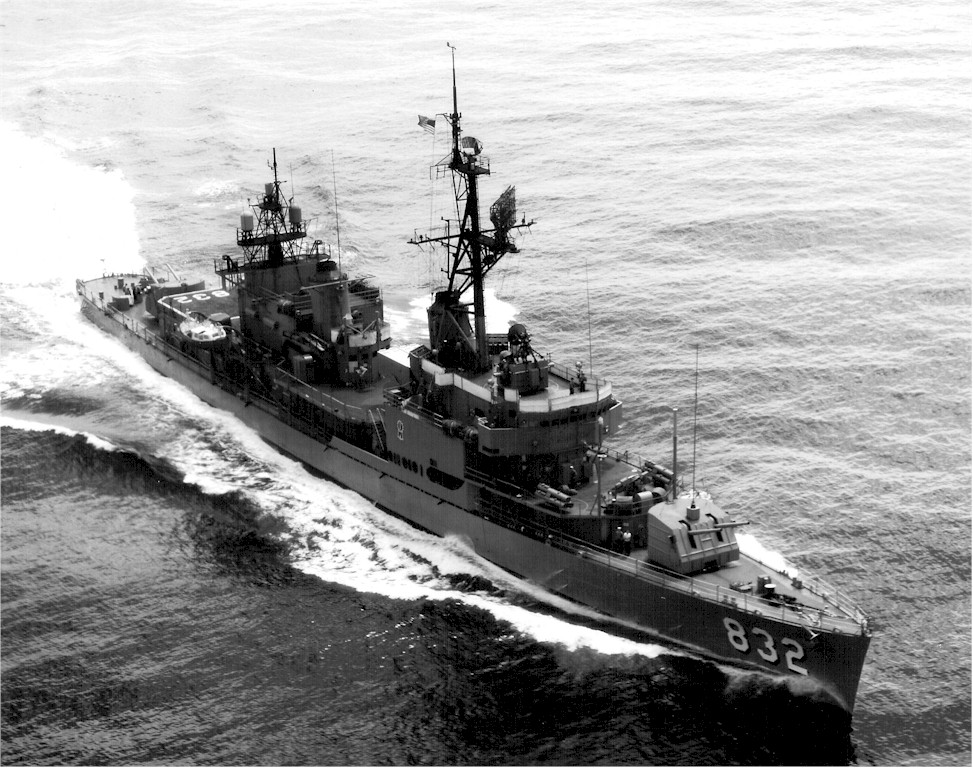
At around 0200 on May 10, the commanding officer of Newport News, Captain Walter F. Zartman, ordered the formation into a line abreast, Hanson to the far left, then Providence, Newport News, Oklahoma City, and Buchanan.
![USS Hanson-DD832_Mount-51R. Dunn, U.S. Navy [Public domain]](https://georgetrowbridges8b.com/wp-content/uploads/2018/07/uss-hanson-dd832_mount-51r.-dunn-u.s.-navy-public-domain-1.jpg?w=1100)
USS Myles C. Fox (DD 829) was ordered farther to the northeast to act as a blocking element in case of enemy patrol-boat activity and to cover the rear of the formation when it would eventually turn to south of west and onto the formation’s firing course.
At 0345, all five warships turned to the firing course 240 degrees (True), roughly parallel to the longitudinal axis of the airfield on Cat Ba Island. At the extreme range of Newport News’s 8-inch guns, the Cat Ba military complexes were the raid’s primary targets. The completely darkened warships commenced firing together at 0347.4
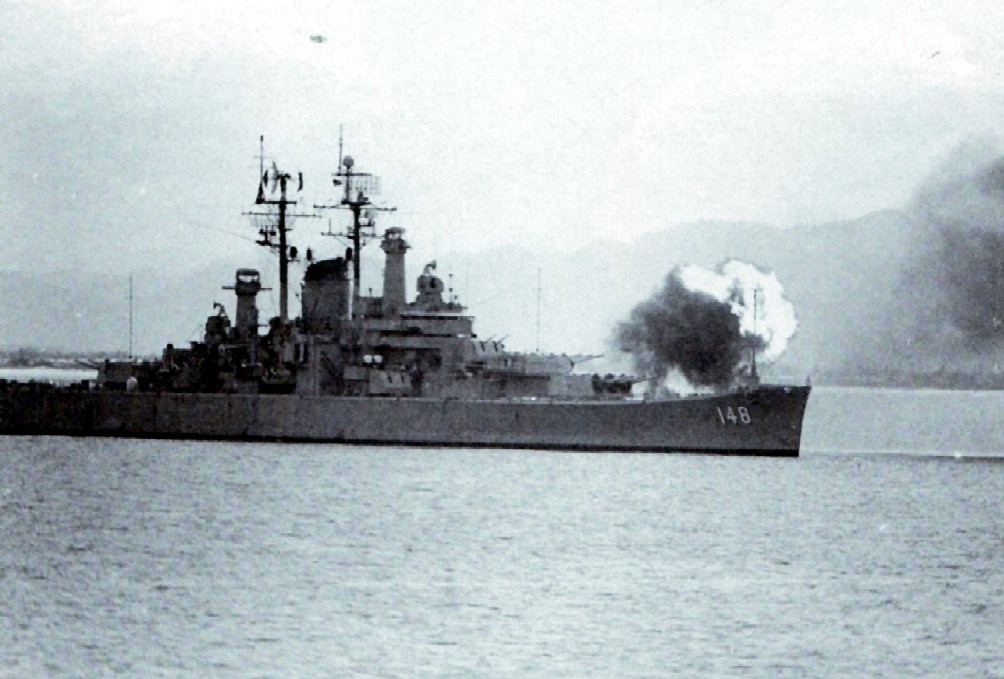
Seventy-seven massive 8-inch rounds and 40, 5-inch rounds from Newport News slammed into the military installations around Cat Ba. Meanwhile hundreds of rounds were fired from the two light cruiser’s 6-inch guns as Hanson’s 5-inch/38 caliber and Buchanan’s 5-inch/54 caliber guns pounded on enemy targets along the Do Son Peninsula. Hanson’s gunfire is credited with suppressing the enemy shore batteries, allowing the cruisers to concentrate their fire on assigned targets.5,6
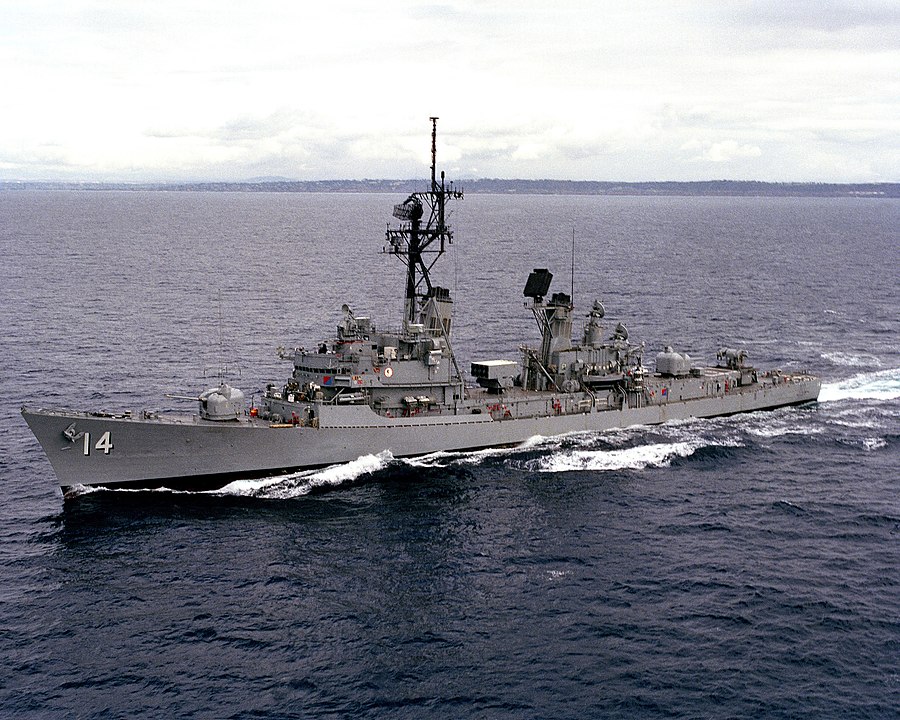
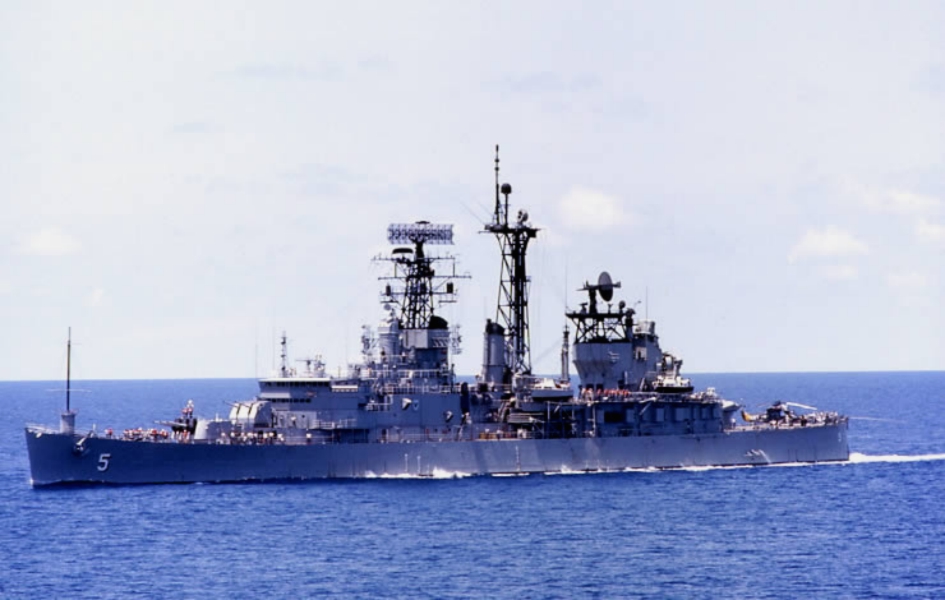

During the raid, USS Hanson entered Haiphong Harbor to suppress hostile shore batteries while enabling Task Force 77 aircraft to continue mining the Haiphong Harbor entrance. This made USS Hanson the last American warship to enter Haiphong Harbor during the Vietnam War and the last one out.
When North Vietnamese shore batteries opened up, effective counter-battery fire from the combined cruiser-destroyer force silenced them. In less than thirty minutes, the entire action was over. Gunfire from the shore batteries had been somewhat sporadic and none of the ships were hit. It is safe assumption that the overwhelming gunfire from the cruisers and destroyers caused most of the North Vietnamese gunners to run for cover and by the time they re-manned their guns, the task group was retiring out to sea. However, the North Vietnamese fired numerous 152-mm shells at the column of ships as they steamed past in the darkness, and the crews in all the ships heard and felt the explosive blasts from the enemy’s incoming rounds.
Operation Pocket Money, was the beginning of a mining campaign that over the next eight months planted over 11,000 Mark 36 type destructor and 108 special Mark 52-2 mines. It is considered to have played a significant role in bringing about an eventual peace arrangement, particularly since it significantly hampered North Vietnam’s ability to continue receiving war supplies7….To read “Striking Eight Bells,” use one of these links to booksellers: Amazon.com: Books, Barnes and Noble Booksellers, BAM –Books A Million and Smashword.com eBooks.

- http://www.vietnamwar.net/HaiphongHarbor.htm
- PIRAZ is a U.S. Navy acronym for Positive Identification Radar Advisory Zone. The zone is defined by the air search radar coverage of a ship patrolling a designated PIRAZ station. PIRAZ ships carried long-range RIM-2 Terrier or RIM-8 Talos surface-to-air missiles to defend their stations. A PIRAZ station was established in the westernmost portion of the Gulf of Tonkin where air search radar coverage might extend over North Vietnam and the U.S. air-strike routes.
- https://en.wikipedia.org/wiki/Operation_Pocket_Money
- https://en.wikipedia.org/wiki/USS_Hanson_(DD-832)
- http://www.uss-newport-news.com/hist/may.htm
- Secretary of the Navy, Meritorious Unit Commendation to USS Hanson for the time period 21 April 1972 to 29 October 1972 including Mộ Đức and Operation Custom Tailor.
- https://www.globalsecurity.org/military/ops/pocket_money.htm
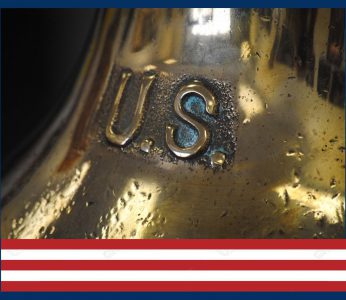
Thank you for a very interesting article. I was kinda like Paul Harvey’s “NOW YOU KNOW THE REST OF THE STORY”!! I was on the USS Ranger (CVA 61) at this time and I remember Cmdr, Smith telling me about this mission as he was flying one of our A6’s with VA-145. He commented about the news that the US could clear the mines as we knew where they were. Cmdr Smith said, “How can they say that! I was laying the mines and I don’t know where they were!” He scared the living daylights out of 2 shore batteries that he flew right down the throat of at about 25 feet! Thanks again!! Harry Hoiland laser guided bomb rep on the Ranger
LikeLiked by 2 people
Great article George!
LikeLike
I was an AOAN on USS Ranger(CVA61) there were a lot of mines being drop that day .I was in VF 21 we drop mines and flew cover for the A-6s and A-7s
LikeLike
Wow! Thank you George for the article and the photos. I was on the USS Hanson through all of that action. My GQ station was on the Signal Bridge with a Redeye missile launcher in case of Mig’s. I had a front row seat to all the NVN raids during that cruise. I highly recommend your book to any destroyer sailor … great read!
LikeLike
YOU WERE ON THE SIG BRIDGE ONLY AFTER WE WERE BOMBED IN 72 BY A MIG
LikeLike
You’re correct Allen. We were notified on a Friday that the Higbee had been hit. We spent the weekend taking on stores and ammunition and departed for Vietnam 4 months before we were supposed to deploy on Westpac. We stopped in Subic on the way and I got trained on the Redeye at Cubi Pt. NAS.
LikeLike
As I recall we rotated from 3 GQ battle stations (A, B & C). During GQ-B, my battle station on the signal bridge as starboard lookout. For GQ A & B I rotated to helmsman on the bridge and as left powderman in Mount 51. I’ll never forget those highly intense combat missions with hundreds of enemy artillery rounds coming in like raindrops. I remember the incredible sounds during those missions with explosions happening all around the ship and of the direct and shrapnel hits on us. I also remember the 6 Redeye missile launchers we had on board. Those were some crazy, yet unforgettable times. Glad I stumbled onto this web page.
LikeLike
all these stories but not 1 about the bombing of the U S S HIGBEE DD-806 APRIL 19,1972 BY A N.VIETNAM MIG…. LOOK IT UP I WAS THERE
LikeLike
Allen, I have run several stories about USS Higbee (DD 806) in the past. The most recent one was published on March 14th titled “North of the DMZ in 72,” the second posted story on the page. https://georgetrowbridges8b.com/2019/03/14/north-of-the-dmz-in-72/ The most recent 28 or so post stories are currently published at one time on this site. After about six months, I often update/revise and rerun older posts, so keep watching, stories about Higbee will soon be up in the que for republishing. Also, I wrote about the MiG attack on Higbee in my book, “Striking Eight Bells.” Thanks.
LikeLike
I recall the incident with the Higbee and went aboard while it was in a Sibic Bay drydock for repair. I recall the fantail being swollen like an egg with the bulkheads pushed outward against the skin of the ship. With all the holes and amount of damage, it’s amazing nobody was killed (thanks to a hang-fire). As I recall, 2 Migs swooped in dropping 500 pound bombs. One apparently missed the ship while a bomb from the 2nd ricocheted off the deck and exploded as it lodged under Mount 52 while the crew was hosing down the barrel to prevent a cook off. Had it not been for the hang fire, the crew would have been inside the mount with the magazine crew directly below, which would have resulted in the loss of many lives. Glad you all survived.
LikeLike
On 7.17.72 USS Warrington DD843 suffered major damage to Engineering spaces Midships and Fan Tail. Takeing her out of action major flooding by seawater and ruptured fuel oil tanks cause.. US Mines in our operational area off of the Harbor BT3 Joseph M. Markowski crewmember DD843.
LikeLike
I remember that mission quite well. On May 8, 1972 at about 2200 hours, USS Providence (CLG-6) enroute to the Haiphong area had a helo accident on the fantail. Admiral Robinson and 2 of his flag officers were killed. (Sam Villa, FTM-3)
LikeLike